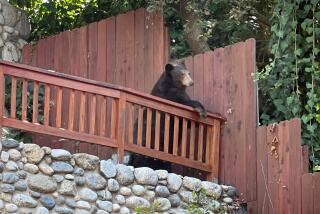OUTDOOR NOTES / PETE THOMAS : Deer Season Opens With New Buck Zone in Riverside County
Saturday marks the beginning of the general deer hunting season, during which up to 1,500 hunters will inaugurate a new buck zone in Riverside County.
Zone D 19, one of 12 D and X zones in Southern California and the Eastern Sierra, was created by the California Department of Fish and Game in an effort to more effectively manage the area’s deer herds.
The new zone was cut from a larger zone D 16. It supports about 2,000 Southern mule deer, animals accustomed to desert habitat. D 19 basically includes the area south of Interstate 10 and East of California 79.
The best hunting, according to DFG biologist Kevin Brennan, will be in the San Jacinto Mountains above Garner Valley, where the buck-to-doe ratio is a healthy 29:100.
Warning to hunters: The new zone also supports considerable numbers of Peninsula bighorn sheep, a state-listed endangered species that, from a distance, could be mistaken for deer. Maximum penalty for killing a wild sheep is $2,000 and a year in jail.
As of Tuesday morning, there were 497 permits remaining for D 19.
Prospects in other Southern California areas range from good to poor:
--D 16 (Imperial and San Diego counties; 977 permits remaining): Spring rains have created ideal conditions, particularly in the San Diego County portion, and bucks should be in excellent shape.
“There’s a good possibility those second-season deer that would normally be spike bucks, will be forked-horn this season, just because of the explosion of vegetation,” said John Massie, a DFG wildlife management supervisor.
--D 14 (San Bernardino Mountains; sold out): “There were so many bucks in the area it became difficult to (locate) the does,” Brennan said. “There’s no reason why anyone shouldn’t get a buck up there.”
Best bets for a big buck: East side of the range in the Morango Creek, Mission Creek or Whitewater Creek areas. Season opens Oct. 10.
--D 12 (Colorado River; sold out): Lots of bucks, but they’re scattered throughout vast Imperial and Riverside counties and are difficult to find. In the river area, most are feeding on alfalfa on Indian reservation land, which is off limits to hunters. In the western portion, there are some big bucks, but hunters will have to work to find them. Bring lots of water. It figures to be hot through much of November. Season opens Nov. 7.
--D 17 (San Bernardino County; sold out): A huge zone, encompassing almost the entire San Bernardino desert, and small portions of Los Angeles, Kern and Inyo counties, but there are only about 700 deer in the zone. If past seasons are any indication the Mid Hills area--between the New York and Providence mountains--will be the place to try. Season opens Oct. 10.
--D 15 (Cleveland National Forest; 906 permits remaining): Plenty of deer, but few will be wearing antlers. Tin Mine Canyon might be a good place to try. Watch out for rattlesnakes. Season is in progress.
--D 11 (Angeles National Forest; 1,663 permits remaining): Last season’s hunters did the best in the Monrovia Peak area of the Baldy District; Strawberry Peak in the Arroyo Seco District and Libere Mountain in the Saugus District. Season opens Saturday.
--D 13 (Los Padres National Forest; 1,607 permits remaining): Good water and forage and healthy deer. The DFG’s Morgan Boucke suggests that hunters try fringes of small controlled-burn areas in the Alamo Mountain, Frazier Park and Mutau Flat regions. Season opens Saturday.
Eastern Sierra hunters face a couple of obstacles: declining deer and bad water. A parasite called giardia is prevalent in some waters, according to the DFG’s Ron Thomas, who said hunters should bring their own water or boil that taken from streams.
Hunter success ratios are among the best in the state in zones X 12 and X 9a, at 36% and 30%, respectively. Both are sold out for hunts that began Sept. 19.
Briefly
SALTWATER--The bluefin tuna bite at the outer banks had shut off until Tuesday, when the Toronado reported 15 bluefin and a striped marlin at the Tanner Bank. Yellowfin schools are still being found, but they don’t appear as plentiful as earlier this month. South of the border, the tuna counts are dropping as well, but dorado fishing remains steady.
Cabo San Lucas: Blue marlin fishing remains steady and the weather has improved with the passing of three hurricanes and tropical storms in the past several days.
CAMPING--Two campgrounds in Kings Canyon National Park will be closed for up to a month while officials spray rodents to eliminate bubonic plague. The Azalea and Crystal Springs campgrounds in Grant Grove were closed because a mouse died of bubonic plague.
CONSERVATION--The National Coalition for Marine Conservation--Pacific Region’s annual North vs. South Billfish tournament, held Sept. 12, resulted in a $35,000 donation to the Pacific Fisheries Enhancement Foundation. The money will be used to finance the construction of a white seabass grow-out facility in Newport Harbor.
More to Read
Sign up for The Wild
We’ll help you find the best places to hike, bike and run, as well as the perfect silent spots for meditation and yoga.
You may occasionally receive promotional content from the Los Angeles Times.






